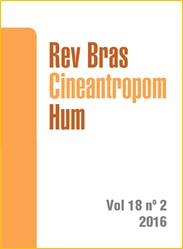Somatotipo, composição corporal e desempenho em ultramaratona
DOI:
https://doi.org/10.1590/1980-0037.2016v18n2p127Resumo
O presente estudo teve como objetivos caracterizar o somatotipo, analisar indicadores antropométricos associados à composição corporal durante a prova e verificar possíveis relações com o desempenho de atletas em uma ultramaratona de 217 km. Para tanto, dez homens (42,8±3,5 anos; 171,4±1,9 cm de estatura; 70,7±3,1 kg de massa corporal; 15±3 anos de treino de corrida) tiveram determinada a velocidade crítica (VC) uma semana antes da competição e foram submetidos às avaliações antropométricas antes, aos 84 km e ao final da prova. Os voluntários completaram a prova em 46,8 ± 3,4h (4,9 ± 0,4 km/h; 33,4 ± 1,8 % VC). Os valores médios equivalentes aos componentes do somatotipo corresponderam a 3,4 ± 0,4 para endomorfia, 5,2 ± 0,4 para mesomorfia e 1,7 ± 0,3 para ectomorfia. Massa corporal, índice de massa corporal, massa magra e circunferência peitoral reduziram (P < 0,05) aos 84 e 217-km comparados aos valores iniciais. Espessura da dobra cutânea de coxa (R= 0,79) e a circunferência de cintura (R=0,64) identificadas antes da prova foram correlacionadas significativamente (P < 0,05) com o tempo final de prova. Dessa maneira, nós concluímos que ultracorredores apresentaram somatotipo médio endo-mesomorfo e reduções tanto de massa corporal como de massa magra durante e após a prova. Além disso, os resultados sugerem que maiores depósitos de gordura corporal concentrados nos membros inferiores e na região abdominal podem ter um impacto negativo no desempenho dos atletas em ultramaratona de 217 km.
Downloads
Publicado
Edição
Seção
Licença

Direitos Autorais para artigos publicados nesta revista são do autor, com direitos de primeira publicação para a revista. Em virtude da aparecerem nesta revista de acesso público, os artigos são de uso gratuito, com atribuições próprias, em aplicações educacionais e não-comerciais, desde que seja dada a atribuição. Esta obra foi licenciada com uma Licença Creative Commons Atribuição 4.0 Internacional - CC BY


